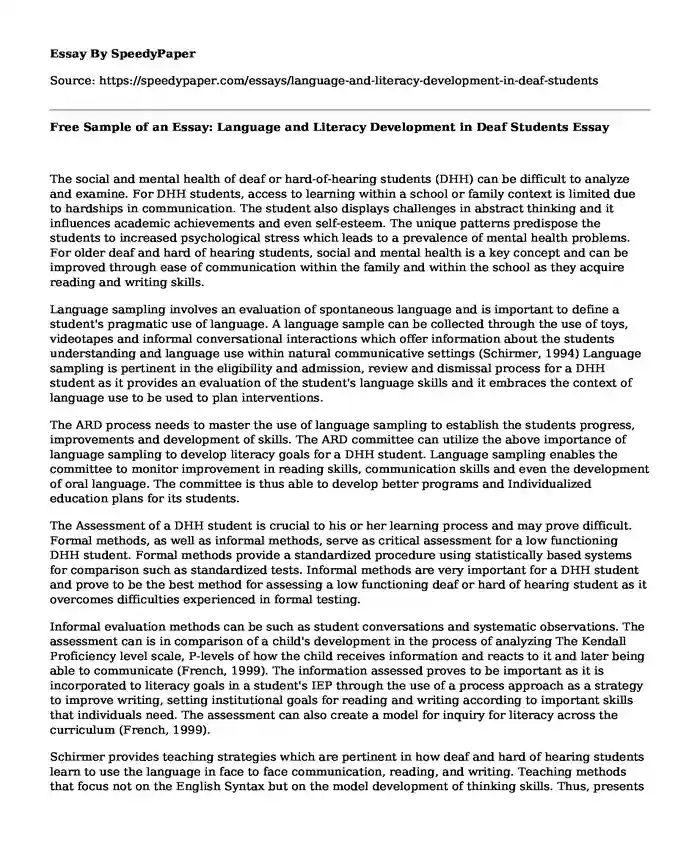
| Type of paper: | Course work |
| Categories: | Special education Language development |
| Pages: | 3 |
| Wordcount: | 653 words |
The social and mental health of deaf or hard-of-hearing students (DHH) can be difficult to analyze and examine. For DHH students, access to learning within a school or family context is limited due to hardships in communication. The student also displays challenges in abstract thinking and it influences academic achievements and even self-esteem. The unique patterns predispose the students to increased psychological stress which leads to a prevalence of mental health problems. For older deaf and hard of hearing students, social and mental health is a key concept and can be improved through ease of communication within the family and within the school as they acquire reading and writing skills.
Language sampling involves an evaluation of spontaneous language and is important to define a student's pragmatic use of language. A language sample can be collected through the use of toys, videotapes and informal conversational interactions which offer information about the students understanding and language use within natural communicative settings (Schirmer, 1994) Language sampling is pertinent in the eligibility and admission, review and dismissal process for a DHH student as it provides an evaluation of the student's language skills and it embraces the context of language use to be used to plan interventions.
The ARD process needs to master the use of language sampling to establish the students progress, improvements and development of skills. The ARD committee can utilize the above importance of language sampling to develop literacy goals for a DHH student. Language sampling enables the committee to monitor improvement in reading skills, communication skills and even the development of oral language. The committee is thus able to develop better programs and Individualized education plans for its students.
The Assessment of a DHH student is crucial to his or her learning process and may prove difficult. Formal methods, as well as informal methods, serve as critical assessment for a low functioning DHH student. Formal methods provide a standardized procedure using statistically based systems for comparison such as standardized tests. Informal methods are very important for a DHH student and prove to be the best method for assessing a low functioning deaf or hard of hearing student as it overcomes difficulties experienced in formal testing.
Informal evaluation methods can be such as student conversations and systematic observations. The assessment can is in comparison of a child's development in the process of analyzing The Kendall Proficiency level scale, P-levels of how the child receives information and reacts to it and later being able to communicate (French, 1999). The information assessed proves to be important as it is incorporated to literacy goals in a student's IEP through the use of a process approach as a strategy to improve writing, setting institutional goals for reading and writing according to important skills that individuals need. The assessment can also create a model for inquiry for literacy across the curriculum (French, 1999).
Schirmer provides teaching strategies which are pertinent in how deaf and hard of hearing students learn to use the language in face to face communication, reading, and writing. Teaching methods that focus not on the English Syntax but on the model development of thinking skills. Thus, presents a realistic approach to teaching and gives a holistic experience to students.
The methods engage the student with the process and lead to development in reading and writing skills and even oral development when used with older deaf and hard of hearing students than those used with younger children. The strategies are more advanced than those used with younger children and students.
References
French, M. M. (1999). Starting with Assessment: A Developmental Approach to Deaf Children's Literacy. Pre-College National Mission Programs, Gallaudet University.
French, M. M. (1999). Planning for Literacy Instruction: Guidelines for Instruction. Sharing Ideas. Gallaudet University, Laurent Clerc National Deaf Education Center, KDES PAS-6, 800 Florida Ave., NE, Washington, DC 20002-3695.
Schirmer, B. R. (1994). Language and Literacy Development in Children Who Are Deaf. Macmillan Publishing Co., 100 Front St., Box 500, Riverside, NJ 08075-7500.
Cite this page
Free Sample of an Essay: Language and Literacy Development in Deaf Students. (2022, Nov 07). Retrieved from https://speedypaper.net/essays/language-and-literacy-development-in-deaf-students
Request Removal
If you are the original author of this essay and no longer wish to have it published on the SpeedyPaper website, please click below to request its removal:
Popular categories




